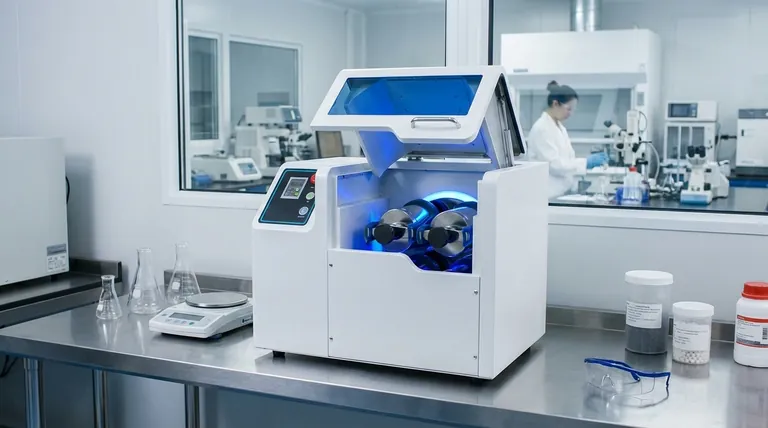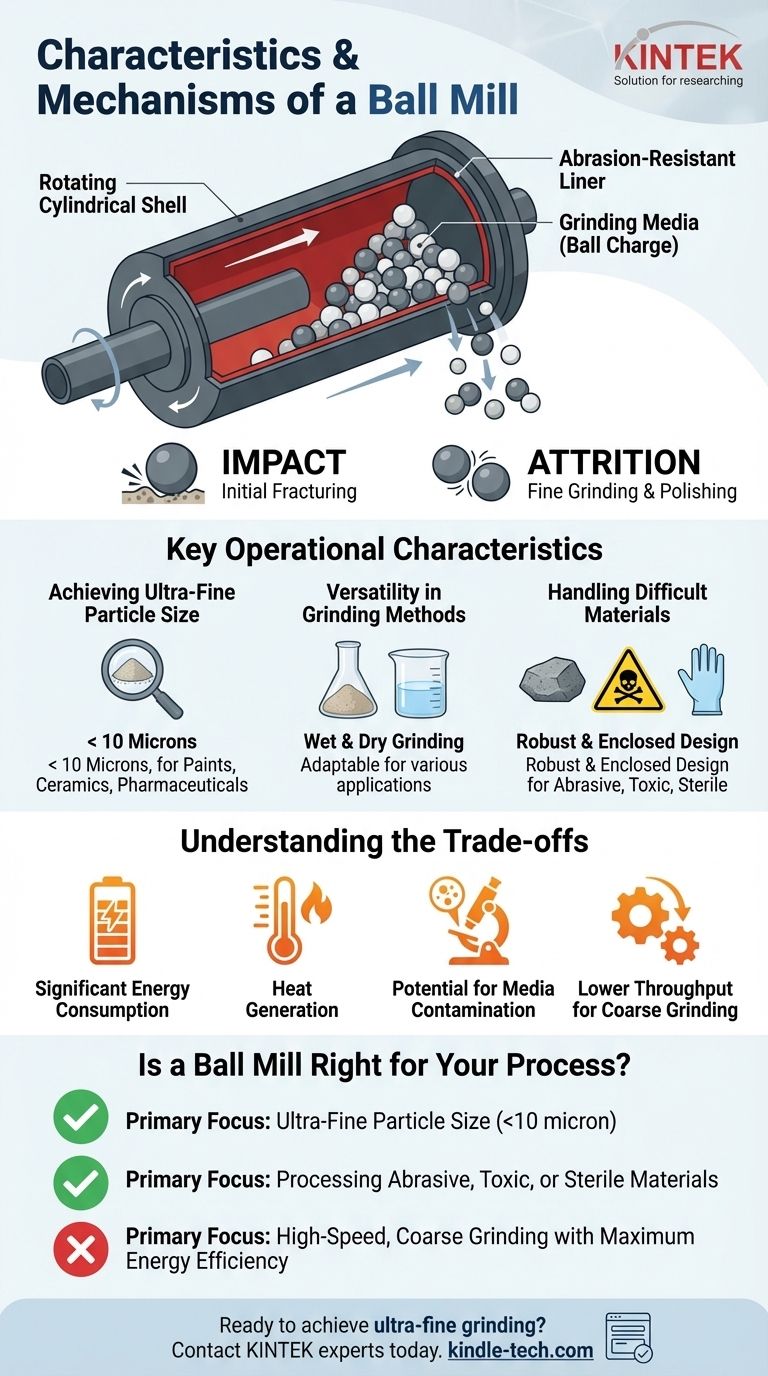At its core, a ball mill is a grinder used to reduce hard materials into an extremely fine powder. It consists of a hollow rotating cylinder partially filled with grinding media, typically steel or ceramic balls. As the cylinder tumbles, the balls are lifted and then drop, crushing the material through impact and grinding it further through the abrasive action of attrition.
The true value of a ball mill isn't just that it grinds material, but that it does so with a specific combination of impact and attrition. This unique mechanism makes it exceptionally effective for producing very fine powders from a wide range of difficult, abrasive, or sensitive materials.

How a Ball Mill Achieves Fine Grinding
A ball mill's effectiveness comes from the interaction of its core components and the physical forces it generates. Understanding this mechanism is key to knowing when and why to use one.
The Rotating Cylindrical Shell
The main body of the mill is a hollow cylinder that rotates on a horizontal or slightly inclined axis. The speed of rotation is critical; it must be fast enough to lift the grinding media but not so fast that centrifugal force causes the media to cling to the sides.
The inside of this shell is protected by an abrasion-resistant liner, often made from manganese steel or specialized rubber, to withstand the constant wear from the grinding process.
The Grinding Media
The "balls" are the actual grinding tools within the mill. They can be made from various materials, including high-carbon steel, stainless steel, ceramic, or even flint pebbles, depending on the application's purity and hardness requirements.
The volume of these balls, known as the ball charge, typically fills about 30% of the cylinder's internal volume.
The Principle of Impact and Attrition
Size reduction happens through two primary actions that occur simultaneously:
- Impact: As the cylinder rotates, it lifts the balls up the side of the shell. Near the top of their arc, they cascade down, striking the material below. This impact force is responsible for the initial fracturing and breaking of larger particles.
- Attrition: As the balls tumble over each other and the material, a constant rubbing and shearing action occurs. This attrition grinds the particles down, polishing and reducing them to a fine powder.
Key Operational Characteristics
A ball mill is defined by more than just its mechanics. Its operational features make it suitable for specific industrial processes where other grinders may fail.
Achieving Ultra-Fine Particle Size
The primary output of a ball mill is a very fine powder. Due to the combined forces of impact and attrition, it can reliably produce particle sizes of 10 microns or less, a level of fineness required for products like paints, advanced ceramics, and pharmaceuticals.
Versatility in Grinding Methods
Ball mills are highly adaptable and can be configured for both wet and dry grinding. In wet grinding, a liquid and dispersing agents are added to the material, which can improve efficiency, prevent dust, and cool the process.
Handling Difficult Materials
The robust and enclosed nature of a ball mill makes it ideal for processing challenging materials. Its liners can handle highly abrasive substances, and the sealed cylinder allows for the safe grinding of toxic or sterile materials without contamination or exposure.
Understanding the Trade-offs
While powerful, a ball mill is not the universal solution for all grinding needs. Its unique characteristics come with specific trade-offs that are critical to consider.
Significant Energy Consumption
Grinding material to a sub-10 micron size is an energy-intensive process. While efficient for the fineness it achieves, a ball mill consumes a substantial amount of power relative to grinders that produce a coarser product.
Heat Generation
The friction from attrition generates considerable heat. For heat-sensitive materials, such as certain chemicals or pharmaceuticals, this can be a significant drawback that may require a wet grinding process or external cooling to manage.
Potential for Media Contamination
The grinding media itself wears down over time. This wear means that tiny particles of the steel or ceramic balls can mix with the product. For ultra-high-purity applications, this contamination is a critical factor that must be managed by selecting appropriate, highly resistant media.
Lower Throughput for Coarse Grinding
A ball mill excels at fine grinding but is less efficient for simple, coarse size reduction. If the goal is merely to break large rocks into smaller pieces, other machines like jaw crushers or hammer mills are often faster and more economical.
Is a Ball Mill Right for Your Process?
Choosing the right grinding technology depends entirely on your end goal. A ball mill is a specialized tool, not a general-purpose crusher.
- If your primary focus is achieving the finest possible particle size (sub-10 micron): The ball mill's combination of impact and attrition is one of the most effective methods available for this goal.
- If your primary focus is processing abrasive, toxic, or sterile materials: The enclosed design and durable, replaceable liners make the ball mill a superior and safer choice.
- If your primary focus is high-speed, coarse grinding with maximum energy efficiency: A ball mill is likely overkill; a different type of crusher or mill will deliver better results for this task.
By understanding these core characteristics and trade-offs, you can leverage the ball mill's unique power for precision grinding where other methods fall short.
Summary Table:
| Characteristic | Description |
|---|---|
| Grinding Mechanism | Impact and attrition for ultra-fine particle size reduction (<10 microns). |
| Versatility | Suitable for both wet and dry grinding processes. |
| Material Handling | Ideal for abrasive, toxic, or sterile materials. |
| Energy Consumption | High, due to the fine grinding process. |
| Heat Generation | Significant, may require cooling for sensitive materials. |
Ready to achieve ultra-fine grinding for your abrasive or sensitive materials?
At KINTEK, we specialize in high-performance laboratory equipment, including ball mills designed for precision and durability. Whether you're in pharmaceuticals, ceramics, or advanced materials processing, our solutions help you achieve the particle size and purity your work demands.
Contact our experts today to find the perfect ball mill for your specific application and enhance your lab's efficiency.
Visual Guide

Related Products
- High Energy Planetary Ball Mill Machine for Laboratory Horizontal Tank Type
- Laboratory Planetary Ball Mill Rotating Ball Milling Machine
- High Energy Planetary Ball Mill for Laboratory Horizontal Tank Type Milling Machine
- High-Energy Omnidirectional Planetary Ball Mill Milling Machine for Laboratory
- High-Energy Omnidirectional Planetary Ball Mill Machine for Laboratory
People Also Ask
- What is the working capacity of a ball mill? Optimize Volume, Speed, and Grinding Media for Maximum Output
- What is the capacity of a ball mill? Optimize Your Grinding Process for Maximum Efficiency
- What are the disadvantages of a ball mill? Key Limitations for Your Grinding Process
- What are the principles of a ball mill? Master Impact & Attrition for Perfect Particle Size
- Which material is crushed by using ball mill? A Guide to Versatile Grinding Solutions



















